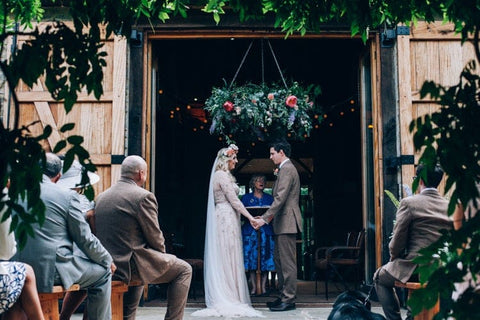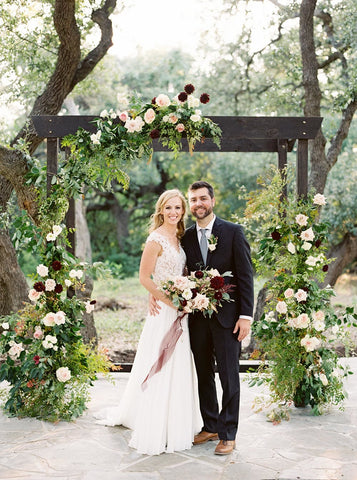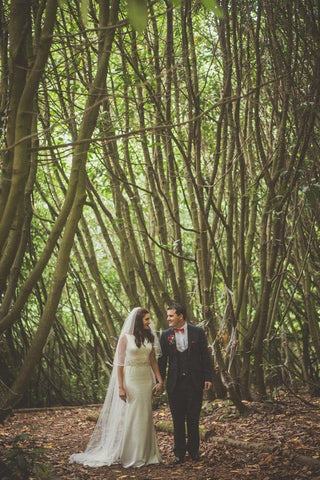11 Weird and Fascinating Wedding Traditions from Around the World
When it comes to love, tradition and weddings, there are no borders. While throwing the bouquet or wearing something blue is a wedding staple in most Western places, there are countless meaningful traditions from around the world that are drastically different from one another. Some are sweet (In Ireland the bride’s feet must stay on the floor at all times when she and the groom are dancing) and some are really weird (In Mauritania, girls between five and 15 years are sent to “fat farms” to pile on the pounds before their wedding.), and some are so fun and unique.Even all of these traditions are outside of your heritage, it is always nice to learn about other cultures and their wonderful wedding rituals.
Make sure you check out our collections of wedding dresses, bridesmaid dresses and flower girl dresses.





India Wedding Captured by Alex Beckett Photography
Here are 11 world wedding traditions, weird and awe-inspiring, that will make you smile, laugh and cry. Check it out!
ITALY
In Italy, confetti are a completely different thing than in the rest of the world. They are candied almonds that are given as wedding favours for the guests. Tradition tells that each confetti should be enjoyed with a happy wish for the bride and groom: health, happiness, children, wealth, and long life together!
CHINA
In Chinese culture, red is a sacred color and it drives evil spirits away. It is also a sign of success, fertility and love. Because all of this, Chinese bride is often dressed in red. In that way they pay homage to their tradition.

Red Wedding Dress [photo: pixabay]
Another wedding tradition from China, and it is a fun one. It is called A Planned Crying. Yes, you read it correctly. The brides have to cry on purpose for an hour each day, for a whole month before their wedding. And in all that crying, other female relatives such as mother of the bride, grandmother and the sisters of the bride join in as well. And on the wedding day, crying song must be sung and the bride will be judged on how beautifully she can do this. To explain a bit, crying in China means the welcoming of a good marriage.
GERMANY
If you think that German weddings are not too different from those in the UK or US, you will may find some of the customs a bit surprising. First, “Polterabend” or smashing a bunch of porcelain for good luck. It is usually celebrated the night before a wedding, and it involves a bunch of friends and family. Once all the smashing is done, the bride and groom are in charge of cleaning up all the mess, as a symbol of how they will need to work together for the rest of their lives.

Sawing a Tree Trunk [photo: Perfect Wedding Guide]
Have you heard about Baumstamm sägen? To translate, it is basically, sawing a tree trunk. In Germany, this practice is designed to illustrate strength of bride and groom as a couple and their ability to work together to overcome challenges.
KOREA
Ok, this is really funny. In South Korea the friends of the groom remove his socks and start beating his feet with dead fish and bamboo sticks, in order to make the groom ready for his first night as a married man. Strange, right?
INDIA
Indian weddings are rich, colorful and traditionally held over three days. But these are not the only differences between Western and Indian culture weddings. In India, instead of a wedding ring exchange, the symbol of marriage is gold or silver pendant on the “Mangal tomorrow” necklace. The pendant is a symbol of two souls. The bride also get bracelets from her mother, and they will symbolically protect her for the rest of her life.

Bride and Groom Captured by Candid Shutters
And this is not all, if a bride in India is born as Mangliks or Mars-bearing, she is considered to be cursed and she will likely cause her husband an early death. And the only way to break the curse is to marry…. a tree. Yes, a tree!! The tree is then destroyed and the curse is broken.
MEXICO

Mexico [photo: pixabay]
In Mexico, it’s common for a bride to have two bouquets. One for a tribute to the Virgin Mary, in hopes that she will bless the marriage, and second for the bride to carry after the ceremony, and later to throw to the girls.
KENYA

Massai [photo: pixabay]
When it comes to weddings, and the look of the bride, hair and makeup is the most important, right? Well, in Kenya, at the wedding ceremony held by the Massai people, the bride’s head is shaved and lamb fat and oil is applied on her head. And this is not all, the father of the bride blesses his daughter by spitting on her head and breasts.
JAPAN

Bride and Groom [photo: pexels]
Traditional Japanese wedding is held in a Shinto temple. A ritual called san-san-kudo is held for the formal part of the ceremony. It consist of drinking sake. Sake is a traditional Japanese rice wine, an alcoholic beverage made by fermenting rice. The newlyweds toast while exchanging vows. Japan still has a tradition of wearing a white kimono, and having a bride painted white. White color represents purity and innocence in most of the world, and because of that bride wears white and is painted white. During the ceremony, bride is obligated to wear a hood. She wears it because of the jealous looks, and to show fidelity to her future husband. Bride changes clothes several times during the wedding. She’s first in white, then she wear a red kimono, and at the end, she wears a western style wedding dress.
SCOTLAND

Scotland [photo: pexels]
Have you heard about a custom of sprinkling the bride? In some parts of Scotland there is still a custom that includes sprinkling the bride. But, don’t think that this involves sprinkling the bride with something nice and gentle, like perfumed water. She is being sprinkled with liquids that guests make from ingredients found at home. And they usually include spoiled milk, eggs and whatever else they can get and what doesn’t smell nice. And afterwards, bride has to walk throughout town like that. But why have this custom? The goal is to see if the bride is stable and strong, because if she can get through that, she can get through all disagreements in marriage.
Bagpipes are a staple of Scottish weddings. The whole ceremony is accompanied by their sound. Usual venues are restaurants or castles. We also have to mention whiskey, which is also a staple, probably more important than bagpipes. Scottish kilts are also a big part, and bride’s white dress usually has an addition of material of which the kilt is made. Another tradition is putting a coin in bride’s shoe, for luck.
JEWISH WEDDING

Bride and Groom Captured by Cameron Jordan
Wedding mediator is one of the most persons on Jewish wedding. A lot of Jewish traditions have gone through the process of modernisation, but in some communities this custom is still being practiced. Mediators get paid only if they have been successful in making the marriage.
Jewish wedding consists of two parts. Engagement and wedding ceremony. Wedding should never be held during the Sabbath or any holiday. Also, they should not be held during mourning periods, Mondays or Wednesdays. Those days are considered unlucky. Bride arrives on the wedding covered with canopy, and the groom, rabbi and witnesses are present. The act of wedding is finished with breaking the glass. This custom of breaking the glass means that the marriage can only end if the shards of the broken glass are put back together.
PHILIPPINES
In Philippines, a day before the wedding, groom has to go to the bride’s family to get their permission. To show them that he is ready to help his future wife in domestic work, groom is tasked with some. For example, he has to wash dishes, iron or dust. A traditional Philippine wedding is held in a church. While exiting the church, newlyweds are being sprinkled with rice. Newlyweds also release two white doves as a symbol of luck and happiness in their marital life. Brides are usually dressed in white with long veil, and grooms wear traditional Philippine clothes. While newlyweds are having their first dance, guests are decorating them with money bills.
DID YOU KNOW?
FLOWER GIRLS AND RING BEARERS

Flower girls [photo: www.weddingsonline.ie by Emma Russell Photography]
Have you ever wonder why we have the flowers and ring bearers? Some sources say the origin of flower girls goes back centuries to Ancient Rome. During the Elizabethan Era, flower girls were carrying a silver cup filled with flower petals and rosemary sprigs, and then they were creating a path of petals for the bride that leads from her house to the church.The petals were considered a symbol of fertility and thought to give the couple good luck.
Read more about the purpose of ring bearers and flower girls on The Feminist Bride.
THROWING THE BOUQUET

Wedding bouquet [photo: Historia Weddings and Events by Nataschia Wielink Photography ]
Throwing the bouquet is still a custom in most of the world. But have you ever thought about how it began? Although today is just a very fun segment on weddings, it’s history is more than just that. It’s an old English custom that started accidentally. Before that, they had a custom of ripping the bride’s dress. They did that because they believed that the bride’s dress brings luck, so all single girls wanted to get a piece of the dress. Obtaining a piece of the dress meant that it will bring love and happiness.
But how it transitioned from tearing the dress to throwing a bouquet? Well, one bride was running away from the girls that wanted to tear her dress and she threw the bouquet to distract them, and accidentally created a tradition that holds up until this day. So thanks to that bride, brides don’t run anymore, they throw the bouquet and the girl who catches it will get married next.
FLOWERS ON THE WEDDING

Flowers [photo: unsplash]
Flowers are an obligatory addition to any wedding. It has always represented fidelity, a new beginning, and even fertility. Having a bouquet on a wedding dates from ancient times. Romans loved to have them on their weddings. In medieval times, they used to put various herbs in bouquets, not just flowers. You could find dill, garlic, parsley and other plants placed in bouquets. They believed that putting those herbs will keep the evil spirits away. English queen Victoria has made flowers popular as a gift of love.
Aside from flower bouquet, she also had a floral crown and flower girls. Customs that are also popular today. More than ever, actually. Each flower has it’s own meaning, so it’s good to examine them before choosing a bouquet. Rose is the most popular and it represents joy and beauty while peonies represent shyness and frightfulness.
WEDDING CAKE

Beautiful Wedding Cake Made by Carrie’s Cakes
There is no wedding without a cake, that is just a fact. And to support that, one of the most oldest wedding traditions is eating the cake. In middle ages, and even ancient Rome, there was a tradition to toss the wedding cake. Guess where? In the bride’s head. this bizarre custom was supposed to represent happiness and fertility. All the wedding guests would then gather around the poor bride and pick up the pieces of thrown cake as a souvenir. Girls that wanted to get married would then put a piece of that cake under a pillow, and that would help them to find a future husband quicker. Fruit cakes were a symbol of fertility , and brides had to cut them and serve them to guests alone.
There is a proof that in middle ages, cakes and pastries were stacked on top of each other forming a tower, and newlyweds had a task of kissing each other over that tower. Over the time, bride didn’t have to cut and serve the cake alone, groom joined her in that task. And along came the custom of feeding the cake. This is also popular today and it symbolizes marital life, togetherness, and love of two people who show by feeding each other the cake that they will take good care of each other.

Bride and Groom Captured by Ruti-Ben Shushan
Browse our elegant flower girl dresses in every style and silhouette.
 USD
USD EUR
EUR
 CAD
CAD
 GBP
GBP









Leave a comment